
The Solar-Terrestrial Centre of Excellence (STCE) is a collaborative network of the Belgian Institute for Space Aeronomy, the Royal Observatory of Belgium and the Royal Meteorological Institute of Belgium.
 |
Published by the STCE - this issue : 2 Oct 2014. The Solar-Terrestrial Centre of Excellence (STCE) is a collaborative network of the Belgian Institute for Space Aeronomy, the Royal Observatory of Belgium and the Royal Meteorological Institute of Belgium. |
| Archive of the newsletters | Subscribe to this newsletter by mail |
NOAA 2158, source of the most recent X-class flare on 10 September, rounded the west limb on 17 September. Though sunspot-wise, the region seemed to be decaying, this certainly has not been the case as far as it concerns its flare activity. So, whether this is still old region NOAA 2158 or some new development in and around what used to be NOAA 2158, this area remains interesting since it did not produce eruptions frequently, but several big ones. In particular the events of 1 and 10 September are standing out, as discussed in these news items at http://stce.be/news/266/welcome.html , http://stce.be/news/267/welcome2.html , and http://stce.be/news/268/welcome.html
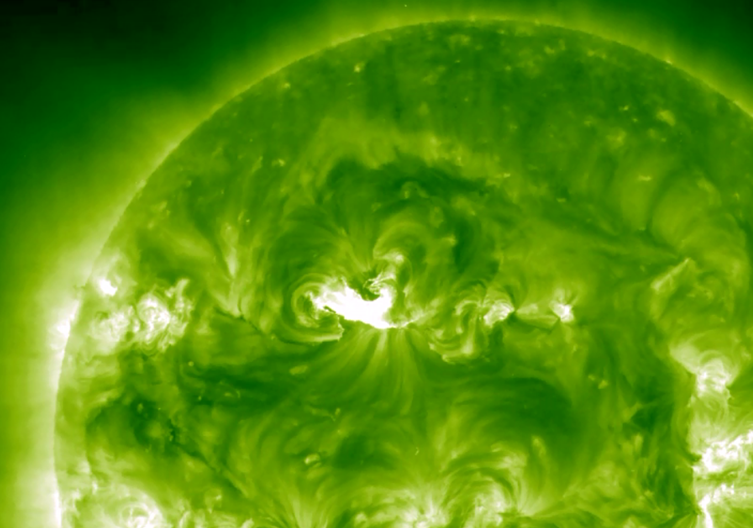
On 24 September, this active area released another strong flare. It was located at the Sun's farside, almost on the opposite side of the Sun as seen from Earth. The flare started around 20:40UT, and was accompanied by post-flare coronal loops ("arcade"), coronal dimming, and an EIT-wave. Unlike the previous two big flares, no enhancement in solar energetic particles was observed this time.
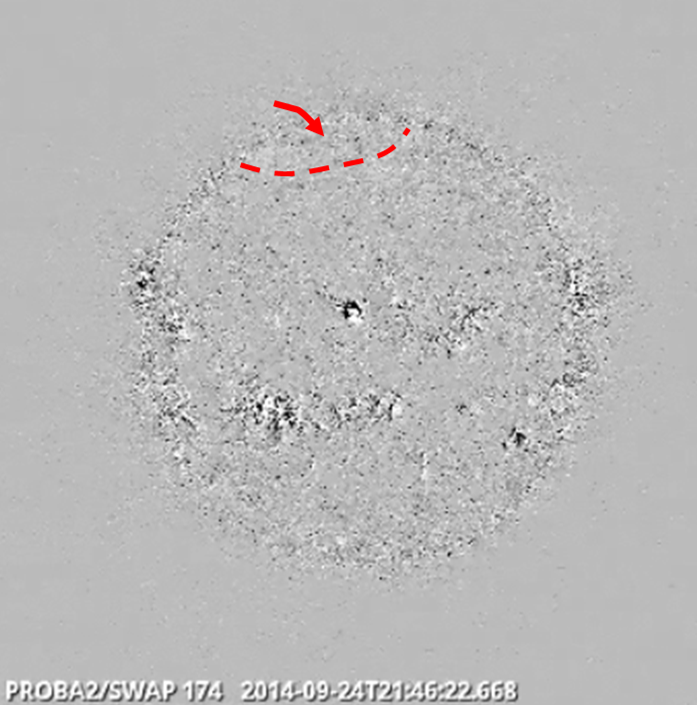
Interestingly, the related EIT-wave made it all the way to the solar north pole and the Earth-facing solar hemisphere. This can be seen in difference images from the PROBA2/SWAP and SDO/AIA instruments. Around 21:40UT, some darkish "movement" can be seen in these images heralding the arrival of the EIT-wave. See this news letter at http://stce.be/news/241/welcome.html for more info on EIT-waves. Amazingly, the SDO images (LMSAL/Nariaki Nitta) also show the related halo coronal mass ejection (CME) leaving the farside solar hemisphere, despite AIA not being a coronagraph!
A movie showing the halo CME, flare and EIT-wave can be seen at http://youtu.be/0vIU9BLR3w0 Imagery was taken from SOHO (http://sohowww.nascom.nasa.gov/home.html), CACTus (http://www.sidc.oma.be/cactus/out/latestCMEs.html), SDO (http://sdo.gsfc.nasa.gov/data/aiahmi/), STEREO (http://stereo.gsfc.nasa.gov/), and PROBA2 (http://proba2.oma.be/ssa).
Solar flare activity fluctuated between low and moderate during the week.
In order to view the activity of this week in more detail, we suggest to go to the following website from which all the daily (normal and difference) movies can be accessed: http://proba2.oma.be/ssa
This page also lists the recorded flaring events.
A weekly overview movie can be found here (SWAP week 235).
http://proba2.oma.be/swap/data/mpg/movies/WeeklyReportMovies/WR235_Sep22_Sep28/weekly_movie_2014_09_22.mp4
Details about some of this week's events, can be found further below.
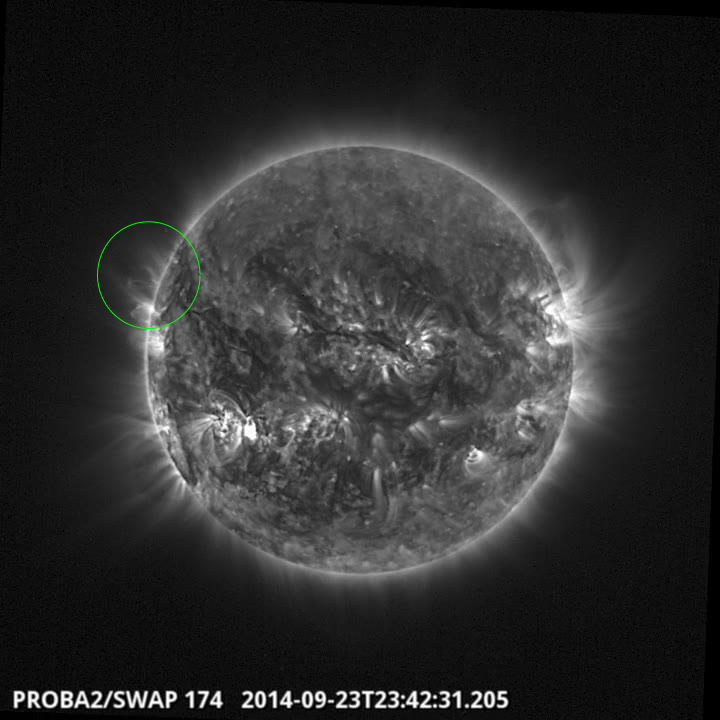
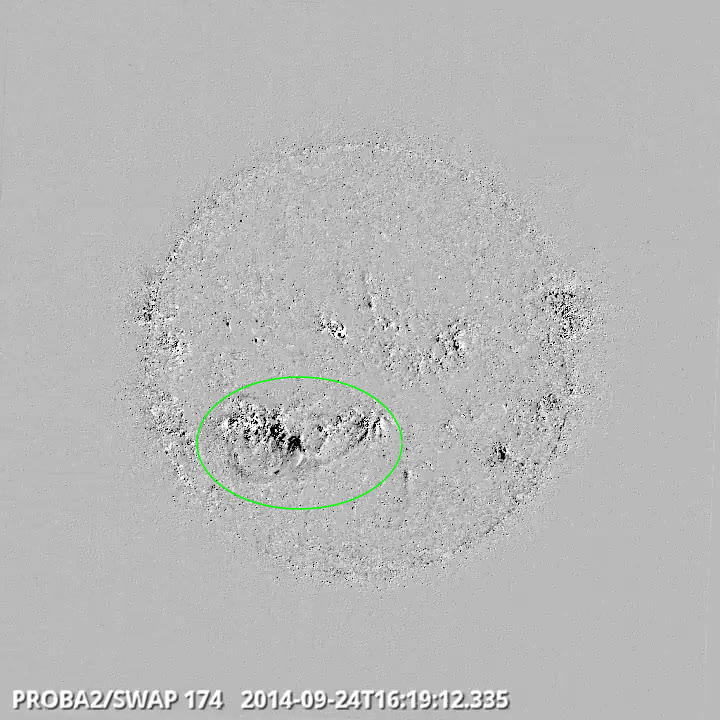
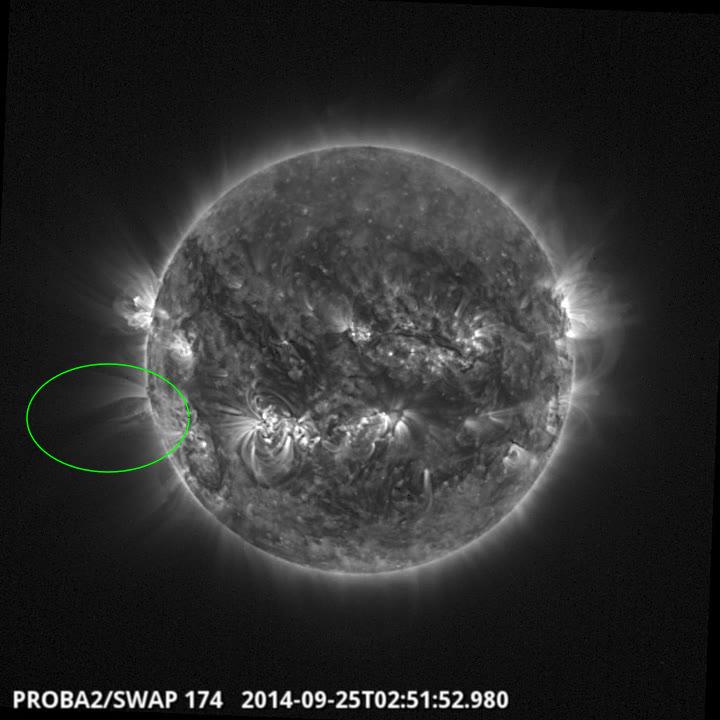
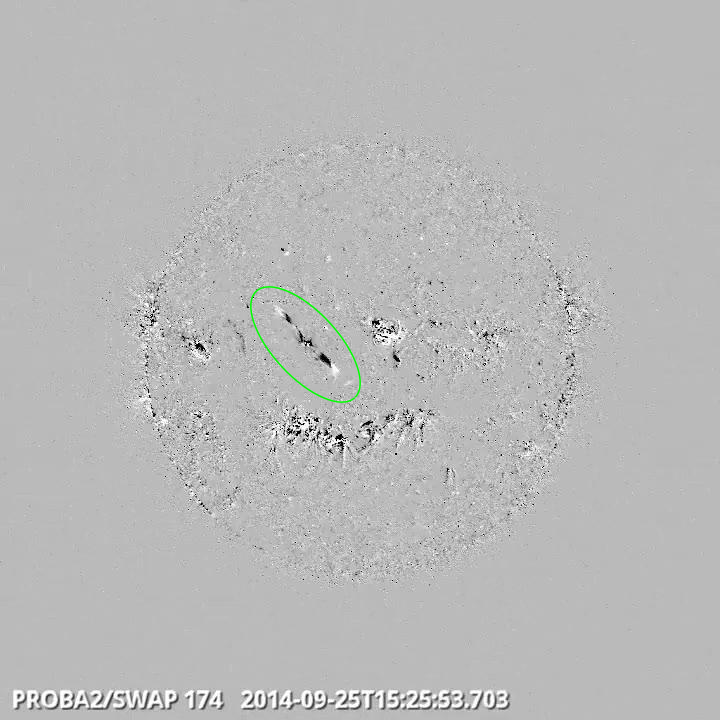
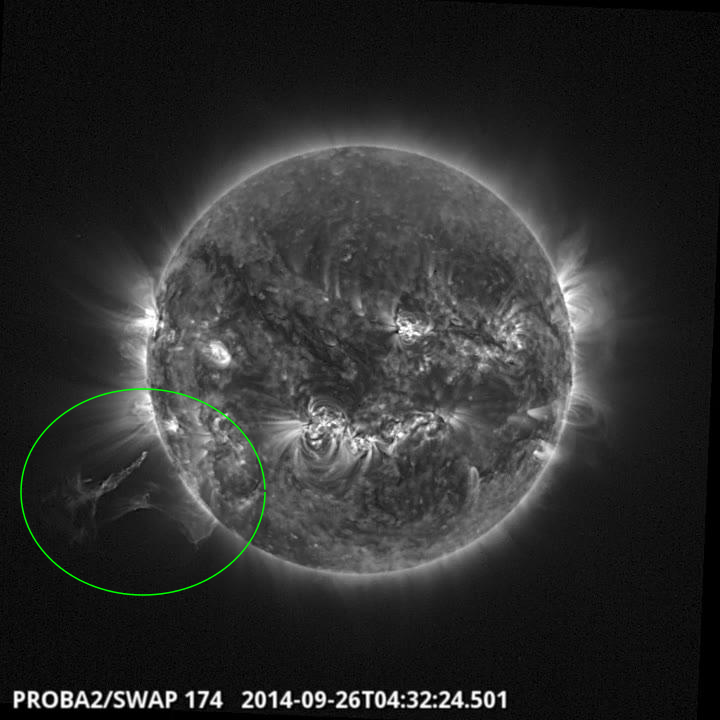
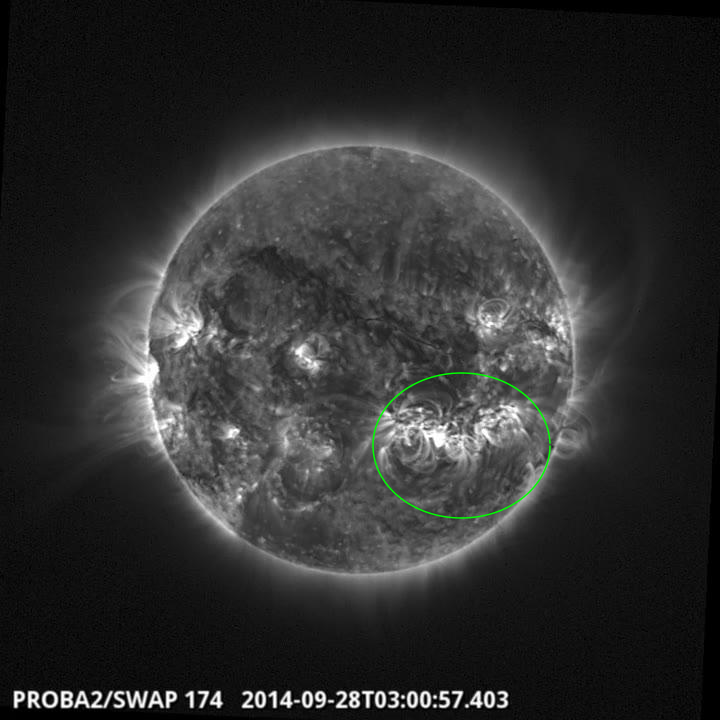
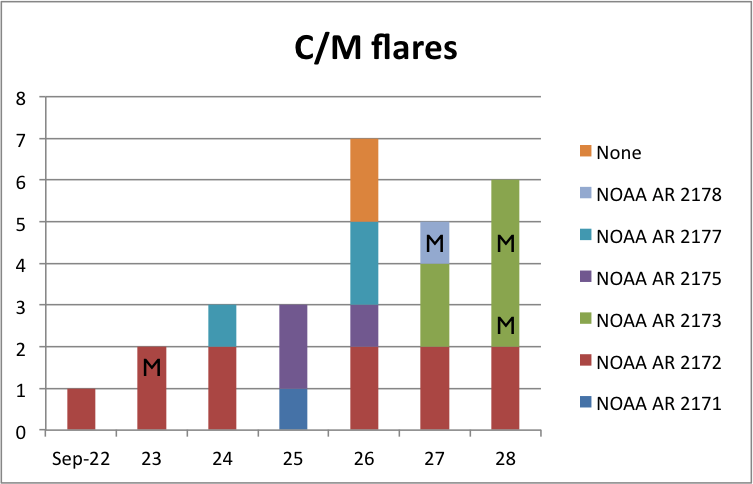
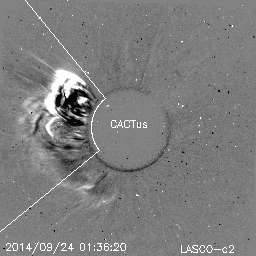
A new active region emerged quickly on the northern hemisphere around the central meridian, it was labelled NOAA AR 2175 on September 26, but the largest flare from that region remained below M level (C 8.6). NOAA AR 2178 produced an M1 flare on September 27 as it turned into view around the east limb.
New region 2173 emerged close to the leading portion of 2172. Interaction between the two active regions resulted in an M5.2 and M1 flare. Neither of those were associated with wide CME's.
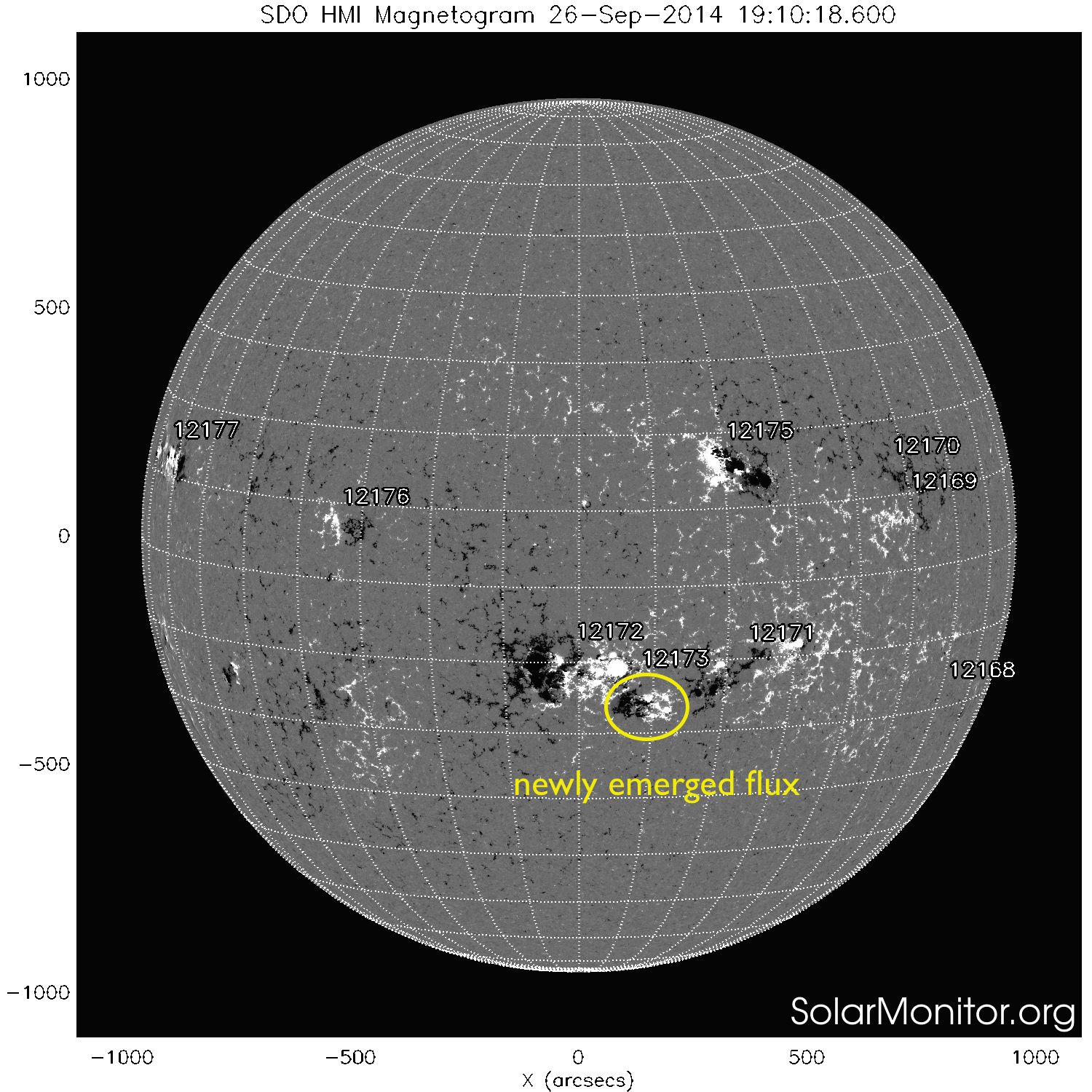
There were 6 partial/asymmetric halo CME's related to far side activity. All originating from old active regions 2157 (4 events) and 2158 (2 events).
Slightly enhanced but relatively stable solar wind conditions were recorded during the week with speeds between 380-500 km/s and total magnetic field 4-8 nT. Bz was variable with negative peaks to -7nT. The magnetic field Phi angle was positive (away) throughout the week. Geomagnetic conditions witnessed some periods of active conditions among otherwise quiet to unsettled conditions.
| DAY | BEGIN | MAX | END | LOC | XRAY | OP | 10CM | TYPE | Cat | NOAA |
| 23 | 2303 | 2316 | 2328 | S13E33 | M2.3 | 2B | 250 | III/2II/2IV/1 | 2172 | |
| 27 | 0832 | 0837 | 0840 | M1.0 | 2178 | |||||
| 28 | 0239 | 0258 | 0319 | S13W23 | M5.1 | 2B | 220 | II/1IV/1 | 2173 | |
| 28 | 1634 | 1733 | 1800 | S15W30 | M1.0 | SF | 19 | 2173 |
| LOC: approximate heliographic location | TYPE: radio burst type |
| XRAY: X-ray flare class | Cat: Catania sunspot group number |
| OP: optical flare class | NOAA: NOAA active region number |
| 10CM: peak 10 cm radio flux |
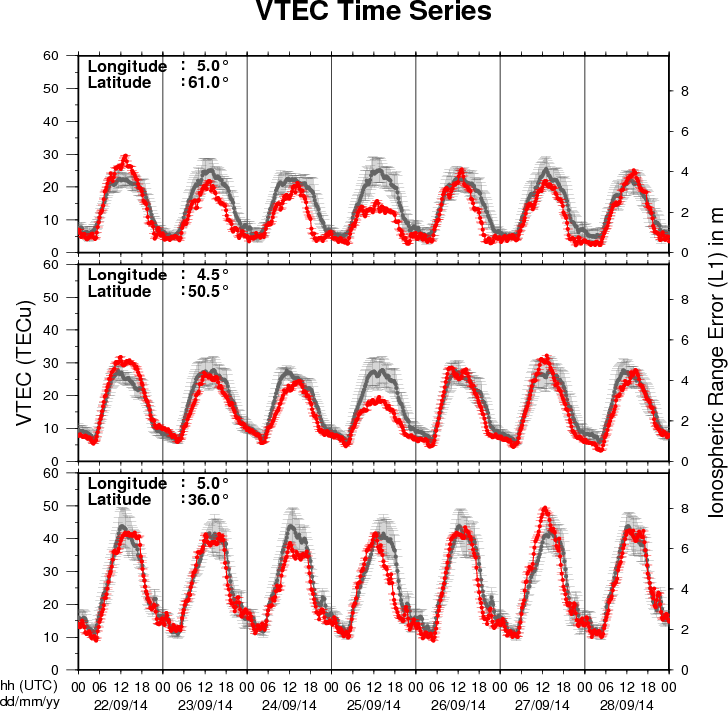
The VTEC is expressed in TECu (with TECu=10^16 electrons per square meter) and is directly related to the signal propagation delay due to the ionosphere (in figure: delay on GPS L1 frequency).
The Sun's radiation ionizes the Earth's upper atmosphere, the ionosphere, located from about 60km to 1000km above the Earth's surface.The ionization process in the ionosphere produces ions and free electrons. These electrons perturb the propagation of the GNSS (Global Navigation Satellite System) signals by inducing a so-called ionospheric delay.
See http://stce.be/newsletter/GNSS_final.pdf for some more explanations ; for detailed information, see http://gnss.be/ionosphere_tutorial.php
Start : 2014-11-12
This conference aims to bring together researchers, engineers,
users in the area of Big Data in the Space sector.
The focus is on the whole data lifecycle, ranging from data
acquisition by spaceborne and ground-based sensors to data
management, analysis and exploitation in the domains of Earth
Observation, Space Science, Space Engineering, Space Weather,
etc.
Special emphasis will be put on highlighting synergies and
cross-fertilization opportunities from domains like Climate Change,
Solid Earth Science, Planetary Sciences, Life Science,
Astrophysics, High Energy Physics, Social Sciences, etc.
We expect this conference to:
* contribute towards a common "Big Data from Space" scientific
and programmatic framework
* widen competences and expertise of universities, labs and
industrial actors
* foster networking of experts and users towards better access
and sharing of data, tools and resources
* leverage innovation, spin-in, spin off of technologies, and
business development arising from research and industry
progress
Website:
http://congrexprojects.com/2014-events/BigDatafromSpace/objectives
Start : 2014-11-17 - End : 2014-11-21
The 11th Edition of the European Space Weather Week will take
place on 17-21nd November 2014 in Liège, Belgium.
The ESWW will again adopt the central aim of bringing together
the diverse groups in Europe working on different aspects of Space
Weather. This includes but isn't limited to the scientific
community, the engineering community, applications developers,
service providers and service end users.
The meeting organisation is coordinated by the Belgian
Solar-Terrestrial Centre of Excellence (STCE), ESA and the Space
Weather Working Team. The local organisation is done by the
STCE.
Website:
http://www.stce.be/esww11/
Start : 2014-12-15 - End : 2014-12-19
The AGU Fall Meeting is the largest worldwide conference in the
geophysical sciences, attracting more than 22,000 Earth and space
scientists, educators, students, and other leaders. For 46 years,
energized and passionate Earth and space scientists from around the
world gather at the AGU Fall Meeting to connect with colleagues,
broaden their knowledge base, and embrace the joy of science. The
2014 meeting takes place Monday 15 - Friday 19 December 2014.
Several sessions about space weather are foreseen:
*
When and Why Does Space weather Forecasting Fail?
*
Addressing Operational Space Weather Needs
*
Near Real Time Data for Earth Science and Space Weather
Applications
*
Understanding Hemispheric Asymmetry and Space Weather
*
Connection of Solar Events With the Variability of Space
Environments
*
Bz from the Sun to the Earth: Observations and Modeling
*
Solar Sources and Heliospheric Consequences of Coronal Mass
Ejections in Solar Cycle 24
*
Advances in Ionospheric Forecasting - Modeling, Observations, and
Validation
Abstract Submission Deadline: August 6, 2014
Website:
http://fallmeeting.agu.org/2014/
Start : 2015-04-20 - End : 2015-04-24
This gathering was born out of the desire to collect in one
place the latest technologies required for advancement of science
in the discipline of Solar and Space Physics. In doing so, it was
recognized that the two 1998 volumes of 'Measurement Techniques in
Space Plasmas' (Particles and Fields) have been a valuable
reference and resource for advanced students and scientists who
wish to know the fundamentals of measurement techniques and
technology.
Website:
https://mtssp.msfc.nasa.gov/
Start : 2015-06-22 - End : 2015-07-02
We invite contributions on novel inversion methods with
application across the geosciences. Of particular interest are 3D
imaging, joint inversion of geodetic, geophysical and geochemical
datasets, and multi-disciplinary interpretation approaches such as
integration of gravity, EM and seismic data or thermo-mechanical
modelling studies constrained by physical parameters.
Modelling of Space Weather Effects: Solar, Magnetospheric and
Earth Resistivity Constraints (IAGA, IAMAS)
In this symposium we welcome contributions on all aspects of the
modelling of space weather and its effects, from the Sun to Earth.
This includes the modelling of the various interactions between
travelling solar storms and the solar wind, magnetosphere,
ionosphere and solid Earth and the validation of models through
measurements. Contributions on models developed to aid end-users,
such as satellite and power grid operators, survive the impact of
space weather are also encouraged.
Website:
http://www.iugg2015prague.com/joint-inter-association-symposia.htm#JA
Presentation given during a users' visit about the STCE operational space weather services and products.
http://www.spaceweather.eu/en/repository/show?id=534
Presentation given during a users' visit about the STCE operational space weather services and products.
http://www.spaceweather.eu/en/repository/show?id=535
Presentation given during a users' visit about the STCE operational space weather services and products.
http://www.spaceweather.eu/en/repository/show?id=536
Presentation given during a users' visit about the STCE operational space weather services and products.
http://www.spaceweather.eu/en/repository/show?id=537
Presentation given during a users' visit about the STCE operational space weather services and products.
http://www.spaceweather.eu/en/repository/show?id=538
Presentation given during a users' visit about the STCE operational space weather services and products.
http://www.spaceweather.eu/en/repository/show?id=539
Presentation given during a users' visit about the STCE operational space weather services and products.
http://www.spaceweather.eu/en/repository/show?id=540
http://www.spaceweather.eu/en/repository/show?id=541